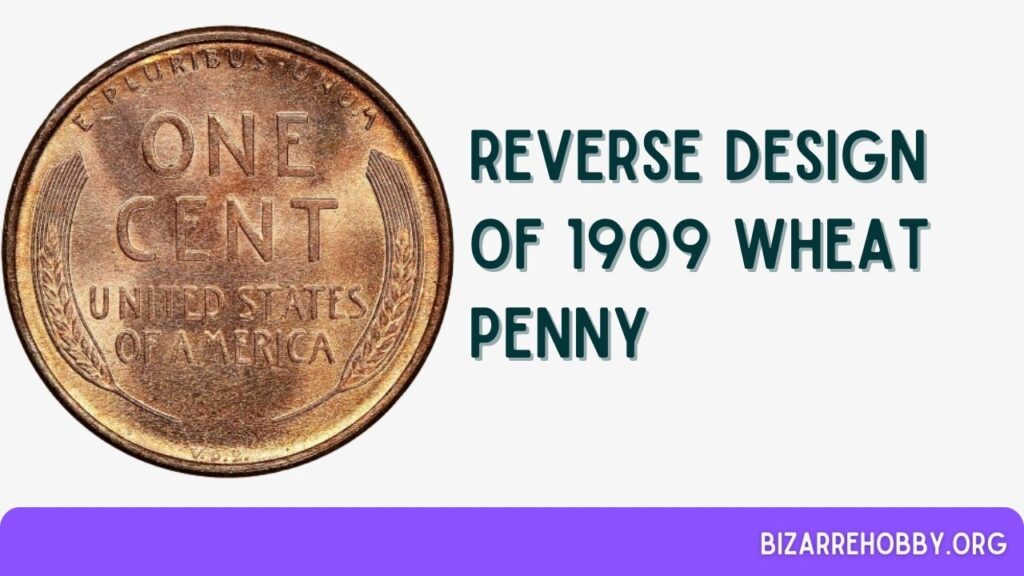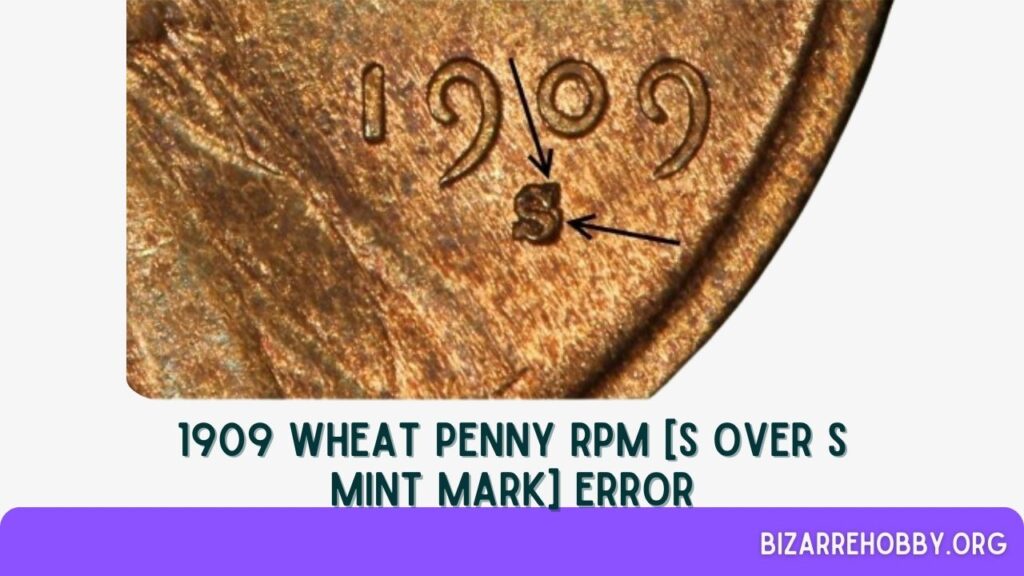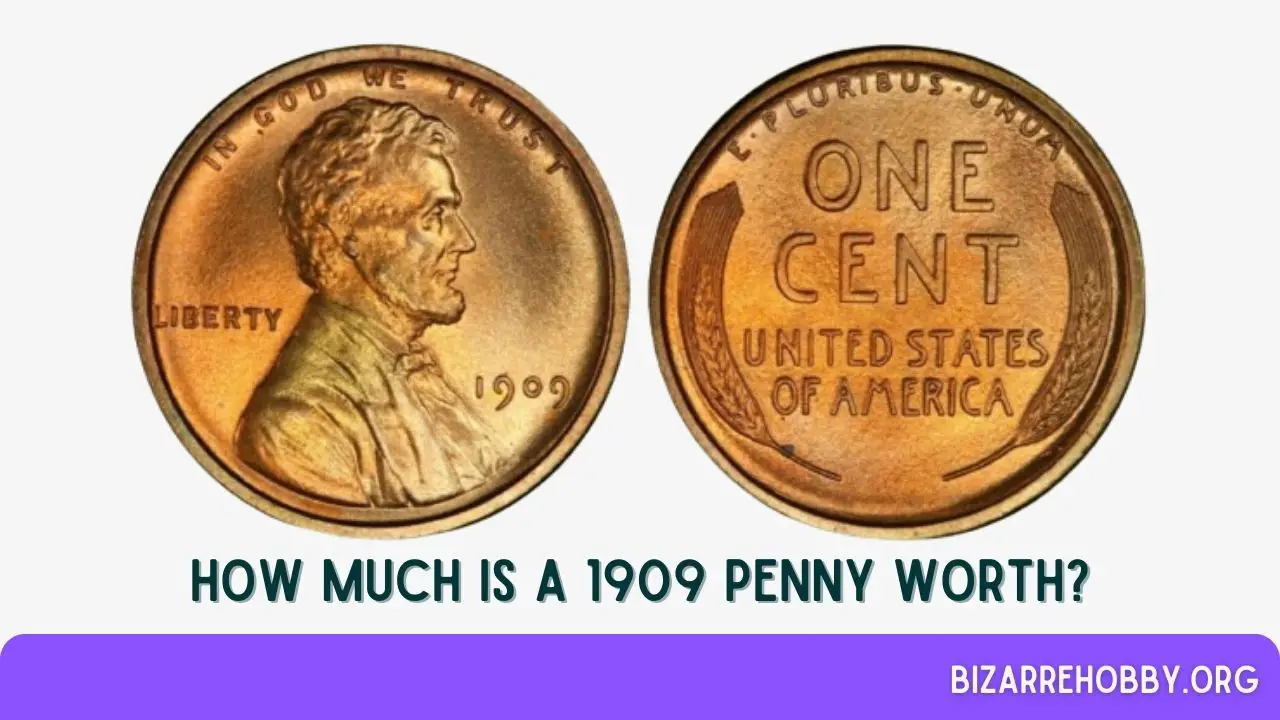The value of a 1909 Wheat penny is influenced by several factors. For example, red-toned coins are typically more valuable than those with brown toning, and the VDB variety is more sought after by collectors compared to the regular ones.
It’s important to note that only around 16,000 of these coins remain in mint condition, with just 3,000 red-colored pennies graded MS 65 or higher. The situation is even more complex for proof coins, with fewer than 150 red proofs rated MS 65 or higher, making them extremely rare and valuable.
Table of Contents
- Value Chart for 1909 Wheat Penny
- Historical Background of the 1909 Wheat Penny
- Types Of 1909 Wheat Penny
- Design of the 1909 Wheat Penny
- 1909 Wheat Penny Grading Guide
- 1909 Wheat Penny Value Guides
- Rare 1909 Wheat Penny Error List
- Where to Sell Your 1909 Wheat Penny?
- What to look for in a 1909 Wheat Penny?
- Which 1909 Penny is Worth a lot of Money?
- How much is the 1909 Philadelphia Penny worth?
- FAQs On the 1909 Wheat Penny Value
- Final Thoughts
Value Chart for 1909 Wheat Penny
| Condition | 1909 Penny | 1909 S Penny | 1909 VDB Penny | 1909 S VDB Penny | 1909 S/S Penny |
|---|---|---|---|---|---|
| Good | $3.38 | $96 | $6.80 | $803 | $110 |
| Very good | $4.63 | $115 | $8.07 | $868 | $123 |
| Fine | $5.84 | $134 | $11 | $993 | $144 |
| Very fine | $6.80 | $166 | $14 | $1,109 | $203 |
| Extra fine | $9.35 | $181 | $17 | $1,256 | $233 |
| AU | $14 | $262 | $21 | $1,494 | $322 |
| MS 60 | $20 | $409 | $35 | $1,899 | $437 |
| MS 63 | $28 | $465 | $35 | $2,332 | $492 |
| PR 63 | $868 | NA | $14,242 | NA | NA |
Historical Background of the 1909 Wheat Penny

The 1909 Wheat penny was introduced to commemorate the centennial of Abraham Lincoln’s birth, marking the first time a real person appeared on an American coin’s obverse. However, the coin’s release was not without controversy.
Critics of the new design style found reasons to object, one being the prominent initials of the designer, which were seen as a form of advertisement.
Subsequent cents minted after the initial 1909 batch did not feature the designer’s initials until 1918, making these early pieces highly desirable among collectors.
Today, only a few tens of thousands of these coins exist in mint condition out of the over 100 million originally produced. The number of proof coins is even lower, with only 272 known to exist in mint state, including 137 graded MS 65 or higher.
Types Of 1909 Wheat Penny
| Location | Year | Minted |
|---|---|---|
| Philadelphia | 1909 Penny | 72,700,000 |
| Philadelphia | 1909 Penny Proof | 2,618 |
| Philadelphia | 1909 Penny VDB | 27,995,000 |
| Philadelphia | 1909 Penny Proof VDB | 1,194 |
| San Francisco | 1909 S Penny | 1,825,000 |
| San Francisco | 1909 S Penny VDB | 484,000 |
| Total | NA | 103,007,812 |
Design of the 1909 Wheat Penny
The 1909 Wheat penny, designed by Victor Brenner, comes in two distinct varieties: with and without his initials. This distinction is unique to the first year of minting.
Obverse Design of 1909 Wheat Penny

The obverse of the 1909 penny features a right-facing profile of Abraham Lincoln, the 16th President of the United States, marking the first time a real person appeared on an American coin.
This side also displays the date and, for coins minted in San Francisco, the mint mark. The VDB pieces include Brenner’s initials beneath Lincoln’s shoulder.
Reverse Design of 1909 Wheat Penny

The reverse side of the coin is elegantly simple, showcasing two wheat ears, the phrase “E·PLURIBUS·UNUM,” the denomination, and the name of the country.
Technical Specifications Of 1909 Wheat Penny
| Specification | Detail |
|---|---|
| Compound | An alloy of 95% copper with zinc or tin |
| Coin Weight | 3.11 g (0.10970 ounces) |
| Coin Thickness | 1.52 mm (0.0598 inches) |
| Coin Diameter | 19.05 mm (1.75 inches) |
| Edge | Plain |
| Face Value | One cent ($0.01) |
| Shape | Round |
1909 Wheat Penny Grading Guide
Grading the 1909 Wheat penny follows the standard coin grading process, but there are specific details that can significantly impact its value. These coins, minted in the first year, come in two types – with and without the designer’s initials.
Additionally, some coins feature notable errors, such as the S/horizontal S RPM, which is common for those minted in San Francisco. Here is a Sheldon grading reference for grading your 1909 wheat penny.
| Sheldon Scale | Grade |
|---|---|
| 1 | Basal State-1 |
| 2 | Fair |
| 3 | Very Fair |
| 4, 5, 6 | Good |
| 7, 8, 10 | Very Good |
| 12, 15 | Fine |
| 20, 30 | Very Fine |
| 40 | Extremely Fine |
| 50 | About Uncirculated |
| 60 | Mint State |
| 65 | Mint State |
| 70 | Mint State |
For a precise valuation, please read my Lincoln Wheat Penny grading guide to determine your coin’s grade accurately.
1909 Wheat Penny Value Guides
The 1909 Wheat penny is notable for its various types, with a total mintage of 103,007,812 coins. The Philadelphia mint produced four different types, including two standard coins and two proofs, while the San Francisco mint issued two types of regular strike pennies, including some highly sought-after error coins.
1909 No Mint Mark Wheat Penny Value [with and without VDB]

The Philadelphia mint produced four types of 1909 pennies, two of which are regular coins with and without the designer’s initials (VDB). The mintage of the non-VDB coins was 72,700,000.
- Brown Coins: In circulated condition, these coins are valued between $1.25 and $12. In mint state, their value ranges from $11 to $54.
- Red-Brown Coins: Graded from MS 63 to MS 66, these coins are valued between $17 and $160. Red pennies can fetch between $45 and $330, with MS 67 graded coins valued at approximately $1,200 to $1,800 due to their rarity.
The Philadelphia mint also produced 27,995,000 VDB pennies in 1909.
- Brown VDB Coins: These are valued between $3 and $450, depending on their condition.
- Red-Brown VDB Coins: These coins range from $22 to $828, except for MS 68 graded coins, which can be worth $18,000 to $22,000.
- Red VDB Coins: Typically valued between $40 and $1,200, with MS 68 graded coins fetching between $55,000 and $66,000.
1909 Wheat Penny Proofs Value [with and without VDB]

In addition to regular coins, the Philadelphia mint produced 2,618 proof pennies without the designer’s initials and 1,194 VDB proof pennies in 1909.
- Brown Proofs: These coins are valued between $385 and $3,600. Rare VDB proofs can range from $6,500 to $29,400.
- Red-Brown Proofs: Without VDB, these coins are valued between $425 and $4,560. With VDB, they range from $7,800 to $100,000.
- Red Proofs: These are the most collectible, valued between $1,000 (PR 63) and $65,000 (PR 68). The most valuable are red VDB proofs, ranging from $12,500 to $15,000 (PR 62) to $135,000 to $162,000 (PR 67).
1909 S Wheat Penny Value [with and without VDB]

The San Francisco mint produced 1,825,000 pennies in 1909, including 484,000 with VDB initials at the reverse base.
- Brown S Pennies: These coins are valued between $60 and nearly $1,000. VDB versions are more valuable, with circulated coins ranging from $610 to $1,920 and mint state coins from $1,650 (MS 60) to $25,000 (MS 67).
- Red-Brown S Pennies: These range from $280 to $4,800, while VDB versions range from $1,800 to $2,220. MS 67 graded coins can fetch between $27,000 and $35,000.
- Red S Pennies: These are the most valuable, with non-VDB coins valued between $330 and $18,000. VDB versions are highly collectible, with MS 67 graded coins valued between $102,000 and $150,000.
Rare 1909 Wheat Penny Error List
The 1909 Wheat pennies feature several notable errors that can significantly increase their value. Some rare VDB pieces with specific imperfections are particularly valuable.
1909 Wheat Penny DDO Error

The double die error appears in both variations of the 1909 penny, with and without VDB. This error results from a misalignment during the minting process, causing doubled design elements, most notably on the word “LIBERTY.”
Approximately 500 VDB pennies from 1909 are estimated to have this error. These coins are valued around $1,000, but auction prices can be much higher. For instance, a 1909 VDB MS 67+ red coin with a DDO error sold for $31,200 in 2023.
1909 Wheat Penny RPM [S over S mint mark] Error

Some 1909 Wheat pennies from the San Francisco mint feature a re-punched mint mark error, where an “S” is struck over a horizontal “S.” This error occurred when the mint mark was incorrectly struck the first time and corrected with a second strike.
These pennies are typically about 10% more valuable than regular ones, but auction prices can be significantly higher. The most expensive brown error coin sold for $875 in 2018, while a red-brown one reached $1,668 in 2006. A red specimen in MS 67 grade fetched $32,900 at auction in 2022.
Other errors
In addition to the DDO and RPM errors, some 1909 pennies exhibit combinations of errors, such as:
- Off-center with doubling error
- Die chip with doubled die error
Where to Sell Your 1909 Wheat Penny?
Knowing the value of your 1909 Wheat pennies is just the first step. If you’re looking to sell them, there are several online platforms where you can do so easily. Each platform has its pros and cons, so it’s important to choose the one that best suits your needs.
What to look for in a 1909 Wheat Penny?
When evaluating a 1909 Wheat penny, there are several key factors to consider that can significantly impact its value:
- Mint Mark: Check for the presence of a mint mark. Pennies minted in Philadelphia have no mint mark, while those from San Francisco are marked with an “S.” The 1909 S VDB penny is particularly rare and valuable.
- Designer’s Initials (VDB): Look for the initials “VDB” on the reverse side of the coin, near the bottom. Coins with these initials are generally more valuable, especially those from the San Francisco mint.
- Color and Condition: The color of the penny (brown, red-brown, or red) and its condition (circulated or mint state) play a crucial role in determining its value. Red pennies in mint condition are the most sought after.
- Errors and Varieties: Be on the lookout for errors such as the Double Die Obverse (DDO) and Re-Punched Mint Mark (RPM). These errors can significantly increase the coin’s value.
- Proof Coins: Proof versions of the 1909 penny, especially those with the VDB initials, are extremely rare and valuable. These coins were specially struck for collectors and have a higher level of detail and finish.
Which 1909 Penny is Worth a lot of Money?
Here are some of the 1909 pennies that are worth a lot of money:
- 1909 PR 67+ RB penny (VDB) – $258,500 (2014)
- 1909 S MS 67 RD penny (VDB) – $168,000 (2022)
- 1909 PR 66 RD penny (VDB) – $70,500 (2019)
- 1909 S MS 67 RD penny – $69,000 (2004)
- 1909 PR 68 RD penny – $59,800 (2010)
- 1909 MS 68 RD penny (VDB) – $56,400 (2021)
- 1909 PR 66 BN penny (VDB) – $41,125 (2016)
- 1909 S/Horizontal S MS 67 RD penny – $32,900 (2022)
- 1909 MS 67+ RD penny (VDB, DDO) – $31,200 (2023)
- 1909 MS 67 RD penny (VDB, DDO) – $24,150 (2012)
- 1909 MS 68 RB penny (VDB) – $22,800 (2018)
- 1909 S MS 67 RB penny (VDB) – $19,200 (2021)
- 1909 MS 66 RD penny (VDB, DDO) – $12,075 (2007)
- 1909 PR 67 RB penny – $10,800 (2019)
- 1909 S MS 66 BN penny (VDB) – $10,000 (2022)
- 1909 MS 67+ RD penny – $8,519 (2023)
- 1909 MS 62 BN penny (VDB) – $4,830 (2002)
- 1909 S MS 65 RB penny – $4,000 (2023)
- 1909 PR 67 BN penny – $3,290 (2018)
- 1909 S MS 66 RD penny (RPM) – $3,290 (2019)
- 1909 MS 67 RB penny – $2,800 (2022)
- 1909 MS 66 BN penny (VDB, DDO) – $2,585 (2014)
- 1909 S UNC Details BN penny -$1,680 (2023)
- 1909 S/Horizontal S MS 66 RB penny – $1,668 (2006)
- 1909 PCGS Genuine BN penny -$1,603 (2018)
- 1909 DDO MS 66 RB penny (VDB) – $1,560 (2021)
- 1909 DDO MS 65 RB penny (VDB) – $1,438 (2008)
- 1909 DDO MS 64 RB penny (VDB) – $1,380 (2008)
- 1909 DDO MS 65 BN penny (VDB) – $1,185 (2016)
- 1909 S/Horizontal S VF 35 BN penny – $875 (2018)
How much is the 1909 Philadelphia Penny worth?
There are two types of 1909 Philadelphia pennies: with and without VDB initials. Regular coins vary in value based on color and condition:
- Brown: $1.25 to $54
- Red-Brown: $17 to $160
- Red: $45 to $1,800
VDB pennies are rarer and more valuable:
- Brown: $3 to $450
- Red-Brown: $22 to $22,000
- Red: $40 to $66,000
FAQs On the 1909 Wheat Penny Value
What is the most expensive Wheat penny?
The most expensive Type 1 penny is the 1944 S MS 66 steel coin, sold for $408,000 in 2021. The priciest error coin is the 1958 DDO red coin in MS 64 grade, which sold for $336,000 in 2018. The most valuable proof is the 1909 VDB PR 67+ coin, sold for $258,500 in 2014. The highest-priced coin in the series is the 1943 D Bronze MS 64 brown piece, which fetched $840,000 in 2021.
What makes a 1909 penny rare?
Most circulated 1909 pennies are relatively common despite their age. However, VDB varieties and coins in excellent condition are scarce. The 1909 S VDB pennies are considered the rarest in the series.
Final Thoughts
The 1909 Wheat penny is a fascinating piece of American numismatic history, celebrated for its design and the introduction of Abraham Lincoln’s portrait on U.S. coinage.
Whether you are a seasoned collector or a novice, understanding the various factors that influence the value of these coins can help you make informed decisions. From mint marks and designer initials to color, condition, and errors, each aspect adds to the story and worth of the 1909 Wheat penny.
